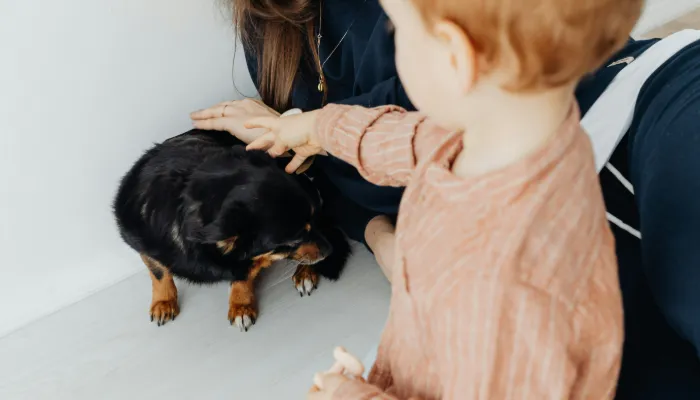Dog owners often wonder how many greetings dogs can come up with within a day’s time. Not only do they have their own ways of communicating but their body movements such as tail wags or eyes, barking and other forms of expressions, are distinct like welcoming a person or another dog which makes it different from human interactions.
Although speech is a form of communication for us humans it is totally absent in dogs, dogs have their unique ways of talking to us. However, a ‘dog translator‘ can break down all these actions but let’s take a look at what’s hello in dog language.

Understanding Dog Communication
Just like with humans where ‘hello’ is a verbal form of greeting, it is important to note that the dog equivalent does not have a vocal greeting. Greeting-like shouting canines have their barks and growls to express ‘excited anger‘, play anger, and even form laughter to wag their tails.
Body Language: The Tail Wag
Discover the hidden emotions behind every wag with this guide to understanding your dog’s tail language.
- Happiness: Dogs and other pet animals often reproduce and imitate actions of getting a treat to showcase the view they expect, at times of petting or giving them a treat by jumping. Dogs can even wag their tails as a signal of happiness when their owners show up. But did you know that the way they wag their tail can give clues to how they’re feeling? For example, a wide relaxed wag signals happiness while a slow wag means uncertainty.
- Erect Ears: When there’s a dog that is attentive to their surroundings or is simply happy to see you, they will instantly lift up their ears. This can indicate that they are focused and willing to engage.
- Play Bow: If your dog stretches its front paws while keeping its rear up in the air, it means that they want to play, and they are greeting you in the traditional dog way.
These too are actions canines do to say a word in a different form, it shows that they want to interact with and are feeling joyous.
Vocalizations: Barking and More
Dogs can be vocal in so many ways, from barking to howling, they have a whole spectrum of sounds. Most people associate barking with dogs, however there are multiple tones that can also be used as forms of barks.
- Excited Barking: When a person hears a dog bark in short and high-pitched sounds, it usually indicates glee alongside a wish to engage with the other person.
- Whining or Whimpering: Whining is a quieter way of barking that indicates that the dog is ready to see you after not seeing you for days.
- Howling: There are various forms of howls and how dogs use them, but for the most part, they are used to get attention or as a form of greeting.
All these vocal forms dogs use are forms of excitement, curiosity, or joy whenever they are around people is something every dog owner understands.
How Dogs Say “Hello” to Other Dogs
Have you ever wondered what the phrase “what’s hello in dog language?” means when a dog encounters another dog? The greeting ritual varies, but here are some things that are usually common that dogs do too:
Greeting Rituals
- Sniffing Each Other: When two dogs first meet each other, the first order of business is always to sniff each other’s behinds. Sniffing reveals a lot of information, ranging from health status to mood. This can be best described as a form of shaking hands.
- Urine Marking: Dogs like to pee in new places they visit and do so as a greeting of marking territory. In the case of newcomers, doing so urinating when meeting new dogs would be pretty common.
Playful Interactions
- Chasing and Wrestling: After greeting, it is very common to engage in some form of playful shenanigan. One of the many activities dogs like after having met each other is engaging in playful wrestling or possibly even chasing each other. Such playfulness shows the dogs are relaxed with each other.
- Tail Wagging: Tail wagging has specific meanings for dogs when they meet other dogs. Just like humans extending their hands in a “hello”, dogs tend to wag their tails as a way of showing friendliness and open saltation.
Through a unique mix of playfulness and scent, dogs are able to communicate their feelings and size up other dogs, effectively creating a bond.
What Does Dog Body Language Tell You About Their Greeting?
Have you ever wondered “What’s Hello in Dog Language?” The short answer is through a physical “full-body expression”. Let’s look at how their anatomy expresses that they are saying “hello.”
Eye Contact
- Friendly Stare: if your dog’s gaze is slightly fixed and his pupils are relaxed, this is a sign of affection
- Soft Blinking: A slow blink is an act of trust in dogs and is viewed as a gentle way of saying hello.
Posture
- Relaxed Posture: An open stance and no signs of tension, which are accompanied by friendly faces, are comfortable around you.
- Leaning In: A dog leaning towards you is often excited to see you and wants to be greeted.
Recognizing these signals makes it easy to tell when your dog wants to say hello and when they require some alone time.
Conclusion
So, “What’s Hello in Dog Language?” The truth is, that dogs have an advanced greeting system for human beings and for each other. Like a wagging tail, a bark, or even a sniff, dogs have their way of saying hello.
By understanding the signals pets give us, we will understand how to respond and relate to them and their feelings more and strengthen our bond with them. Dogs are the best communicators and how they say hello is only one of the many ways they show affection.
